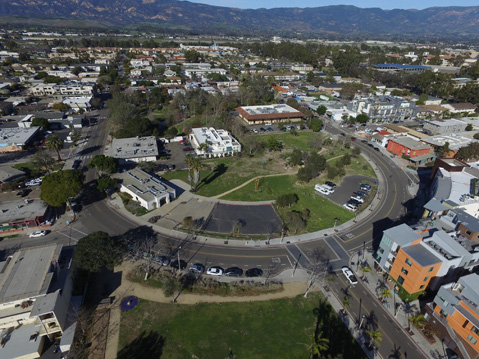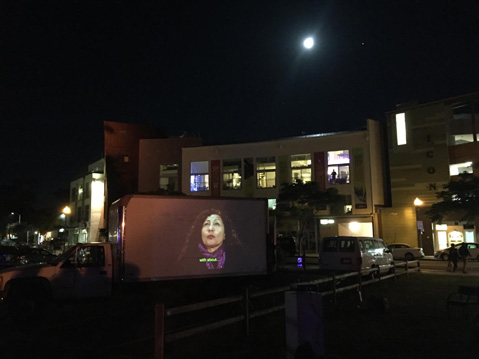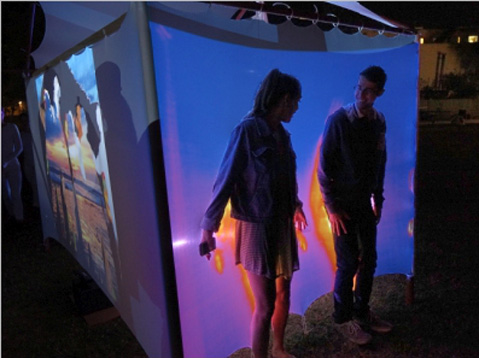Isla Vista Conference Looks to the Past to Shape the Future
Revisiting the Years from Riot to Mass Murder

How does a community rise from the ashes of tragedy, phoenix-like, to make itself anew?
That was the question for young and old at “The Beloved Community,” the first annual Isla Vista Conference, held partly at UCSB’s Embarcadero Hall, the very site where rioting students burned down the Bank of America in 1970, enraged by the Vietnam War, the draft, and their own disenfranchisement.
The bank was “the biggest capitalist thing” in Isla Vista, said Dick Flacks, a UCSB professor emeritus of sociology, speaking to an audience of about 30 people on Saturday and recalling the chaotic Year of Rebellion. But in the aftermath of vandalism, riots, beatings, arrests, and the police shooting of a UCSB student (the police called it accidental), came a “tremendous period of ferment and activity,” Flacks said.
“The past two years reminds me of that time,” he said. “The spirit seems to come back whenever people are faced with a crisis that brings them together.”
Many participants in the two-day conference spoke about their efforts to improve conditions for 15,000 Isla Vistans as a transformational experience. What happens in this student ghetto plagued by alcohol-fueled crime and overcrowded, dilapidated housing stock, they said, turns out to be just as important as what happens at the prestigious campus next door.
The weekend event, named after the phrase that Dr. Martin Luther King Jr. used for a just community, was dedicated to the memory of the six UCSB students who were murdered in Isla Vista on May 23, 2014. The killer also shot himself.
“It’s been two years — a breath and a blink,” said Melissa Cohen, general manager of the Isla Vista Food Cooperative, who told the audience she had spent half of her 34 years in the community.”
“I hope we can keep telling the story,” Cohen said. “That’s what will keep the memory of not just the six, but the seven, alive.”

At the same time, UCSB Associated Students, the conference organizers, sought to celebrate what Victor Ríos, a UCSB sociologist and keynote speaker, called “collective effervescence” — the magic, he said, that happens when people listen to each other and work together.
“In 2014, our community may have been victimized, but we have not allowed ourselves to become victims,” Ríos said. “Isla Vista can become a laboratory for change, a testing ground for a little utopia. Utopia doesn’t have to be massive. Maybe later we can scale it up.”
After the bank burning of 1970, Flacks and others recalled, the university poured hundreds of thousands of dollars into Isla Vista to help make amends. Permanent institutions were founded: among them, the Isla Vista credit union, the first of its kind in the nation; Isla Vista Foot Patrol, an early model of community policing; and the Isla Vista Recreation and Park District, Tenants Union, and Isla Vista food and housing cooperatives. All of these institutions remain in operation today, stabilizing influences in a community in flux.
“Many people learned a great deal from their participation in this effort,” Flacks said. “I.V. became an educational framework in its effort to become a community.”
In an election after the 1970s riots, he noted, it was Isla Vista students who crucially helped defeat the county sheriff who had dropped tear gas on them from helicopters.
“From that day on, Isla Vista has understood that it can be a powerful voting bloc,” Flacks said.
Likewise, since the tragedy of 2014, the community has seen the advent of policing that engages both students and property owners in helping to quell the mega-parties that cause havoc on weekend nights. Residents have secured $500,000 in county funding toward the renovation of an abandoned church as a community center. In November, they will vote on the formation of a community services district, funded by a utility tax that is shared by students and landlords alike.
“Isla Vista is loved,” said Yonie Harris, a former Isla Vista activist and UCSB Dean of Students. “It’s a community that is open, generous, exuberant, and tolerant.”
Sheriff’s Lieutenant Rob Plastino, the outgoing head of the Foot Patrol, spoke about his hopes for an Isla Vista where self-policing is the norm.
“You have a right to party, sure, but within reason,” he said. “The cops aren’t needed if there are no large crowds. That’s where we want to go with this.”
Senior Sheriff’s Deputy James McKarrell, the Foot Patrol community liaison, said law enforcement officers have to change their tactics on the street. They must explain why, for example, after arresting a young man for drunken behavior, they order him to sit down on the curb, McKarrell said: It’s to prevent him from running away and getting hurt.
“The days of ‘Do what I say because I say it��� are gone,” he said. “We’re contacting community members who rely on us, and we want them to trust us. Believe it or not, we’re family.”

During the past two years, again responding to a crisis after decades of neglect, UCSB has poured money into Isla Vista, buying the Tropicana apartment buildings for $156 million, beefing up the presence of university police, and pledging $1.4 million for new services over seven years, if the November ballot measure is approved. Forty percent of UCSB students live in Isla Vista.
Yet in the past, university support for Isla Vista has been sporadic, at best. An aging, inferior housing stock remains the 50-year legacy of the university’s early decision to cede ownership of the land to private real estate developers.
Harris characterized UCSB’s record in Isla Vista as “a flurry of activity and engagement and money for awhile, then waning of interest and withdrawal of money.” Flacks described it as “a rollercoaster of engagement and disengagement over the years.”
But Paola Dela Cruz, who cochaired the weekend event for Associated Students, is optimistic. She hopes the university will consider setting up a center for community engagement in Isla Vista.
“My future for Isla Vista is to look for more collaboration between faculty and community organizations,” Dela Cruz said.
On Saturday night, Isla Vista’s downtown park was filled with live blues music and illuminated, multicolored art installations. Families and couples strolled around, taking in the scene.
At 9 p.m., Plastino, who transfers out of the Foot Patrol on Tuesday after three years there, ordered the illumination of the Sheriff’s dive boat floating just offshore with a thousand blue LED lights. He said this “installation” was being called “Lt. Plastino’s Liquescent Lifeboat.”
Under a full moon, fittingly a blue moon, a flotilla of intrepid kayakers from the UCSB Excursion Club, also outfitted with blue LEDs, performed a watercraft ballet in the swells near the dive boat, waving their lighted paddles at the shore. From the bluffs, a shout went up from a small crowd of onlookers, who signaled back with lighted cell phones.
It was a hopeful moment, and it was pure I.V.
To view the video “When Amerika Burned by the Sea: The Isla Vista Riots,” go to vimeo.com/36123261.



